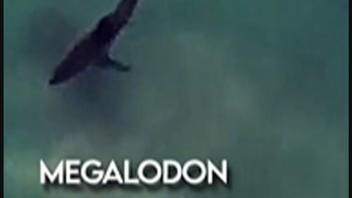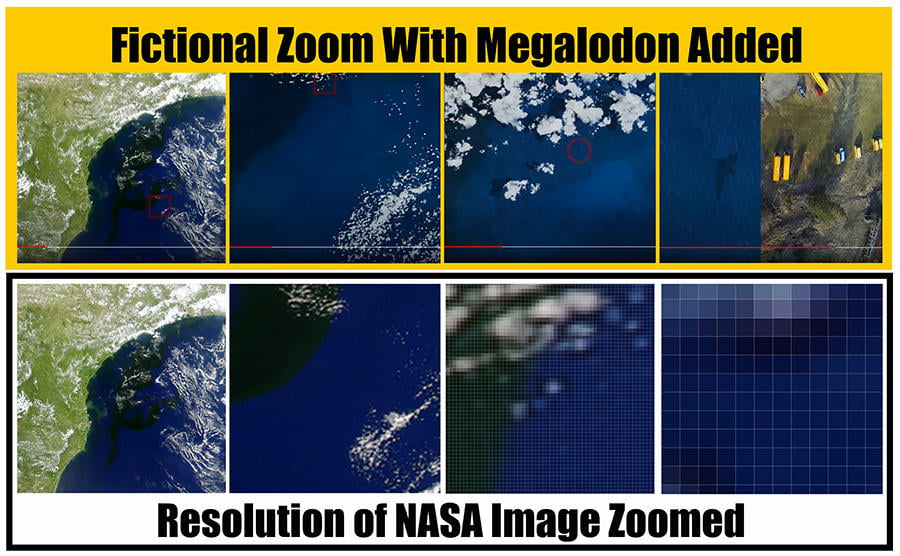
Did a documentary produced for the Discovery Channel's "Shark Week" provide "new evidence" from a NASA satellite photo that shows a living megalodon off the coast of Brazil? No, that's not true: The megalodon was a species of megatooth shark that has been extinct for several million years. The Shark Week episode "Megalodon: The New Evidence" has disclaimers and is a work of fiction -- there is no new evidence these giant sharks are still alive.
A clip from the 2014 "Shark Week" episode resurfaced on TikTok on September 15, 2023. The video (archived here) was posted by @xitclip with the caption:
Mystery Sea Discovery. #mystery #discovery #megalodon #oceandiscovery
This is what the post looked like on TikTok at the time of the writing of this fact check:
(Source: TikTok screenshot taken on Fri Nov 10 17:08:51 2023 UTC)
There is some scientific question regarding how long ago megalodons became extinct, based on the age of megalodon fossils. An academic article, "The Early Pliocene extinction of the mega-toothed shark Otodus megalodon: a view from the eastern North Pacific," published on February 13, 2019, (years after this "Shark Week" episode aired) carefully reviewed records of megalodon fossils from around the world. After review, their hypothesis pushed the estimated time of extinction back by about 1 million years from 2.6 Ma to 3.6 Ma -- Ma stands for "mega annum," representing 1 million years.
OLE [optimal linear estimation] analysis of a revised global dataset of Otodus megalodon occurrences strongly suggests that Otodus megalodon was extinct by the end of the early Pliocene (3.6 Ma)
The footage of the 1:02-minute clip posted on TikTok is contained within a 1:39-minute clip that Discovery posted on YouTube on August 15, 2014. The 41:27-minute-long full episode of "Megalodon: The New Evidence" (purchase required) can be found on the Shark Week YouTube channel. This episode was a follow-up to "Megalodon: The Monster Shark Lives," which aired a year earlier, on August 4, 2013.
"Megalodon: The New Evidence" features a disclaimer that shows briefly at the start and end of the full episode. It says:
None of the institutions or agencies that appear in the film are affiliated with it in any way, nor have approved its contents.
Though certain events and characters in this film have been dramatized, Megalodon was a real shark.
Legends of giant sharks persist all over the world and there is still debate about what they might be.
Two men appear in the short clip posted on TikTok. The host is Emmett Miller. In real life, Miller is a freelance ABC Network correspondent; in this production, he hosts the show as himself. The marine biologist interviewed, Colin Drake (pictured in the screenshot above and below), is played by actor Darron Meyer.
The IMDb bio for Meyer includes some photos from his Colin Drake role, but neither Discovery Megalodon episode is listed in the actor's body of work on IMDb. Meyer is included in the IMDb entry for 'Megalodon: The Monster Shark Lives," and there is no entry for the follow-up episode.
(Source: IMDb screenshot taken on Fri Nov 10 18:14:40 2023 UTC)
The fictional scenario presented in the clip features a real NASA Earth Observatory satellite image taken January 19, 2014. It shows a bloom of microscopic organisms off the coast of Brazil. This image is also part of the Visible Earth NASA image catalog; the high-resolution version of the image is 4,000 by 4,000 pixels square. The marine biologist character Colin Drake explains that the new evidence of a living megalodon was found in this satellite image.
The video shows progressive zooming in on the NASA image, but at a certain point what is shown in the detail departs from reality. Compared with another satellite image, the shape of a giant megalodon shark is purported to be larger than a school bus. The true NASA image is not a comparable resolution to the satellite image of the school bus parking yard, and no 70-foot-long shark shape is visible when zooming in on the NASA image.
In the Earth Observatory FAQ, the image resolution is explained:
What is the highest resolution of a single pixel for the datasets we use?
The highest resolution of a single pixel that we publish is from astronaut photography. The resolution varies by lens and can capture up to 3-meters (˜10 feet) in spatial resolution. You can see houses and streets at this resolution, but they are not very clear. Also, because this data is taken by a human on the International Space Station, there most likely is not a consistent revisit period. The rest of the satellite imagery we have has a minimum spatial resolution of 10 meters (˜33 feet).
What this means is that each pixel in an Earth Observatory image will represent no less than 33 square feet of the Earth's surface. A 70-foot-long area, such as the length of a megalodon, would be represented by at best two pixels in this 4,000-by-4,000-pixels square image. This is not enough to yield details such as the fins and taper of the megalodon's tail seen in the fictional zoomed images featured in the Discovery show.
In the Lead Stories composite image below, four screenshots from the YouTube video (outlined in yellow) show the progressive fictional zoom that gains detail with each frame, finishing by comparing the size of the megalodon's fake silhouette with a satellite image of school buses, purported to be the same resolution. The image of the school buses is a much higher resolution than that described in the Earth Observatory FAQ.
(Source: Lead Stories composite image with YouTube screenshots and NASA image taken on Fri Nov 10 22:52:10 2023 UTC)
The second series of four images (above) was derived from the real NASA image, a 29-megabyte GeoTIFF file downloaded from visibleearth.nasa.gov. Each frame approximates the suggested zoom of the frames above them, but this does not produce more detail; the pixels are just displayed larger. There is no silhouette of a megalodon visible in the original NASA image.
Lead Stories contacted NASA's Earth Observatory for comment and will update this fact check as appropriate.



















